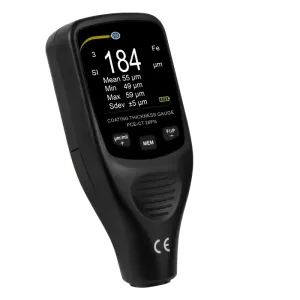Coating Thickness Gauge
The Coating Thickness Gauge is an indispensable tool in various industries, offering a precise and efficient way to measure the thickness of coatings applied to a variety of substrates. This critical device plays a crucial role in ensuring the quality, safety, and durability of products in sectors ranging from automotive manufacturing and aerospace to painting and corrosion prevention.
What is a Coating Thickness Gauge?
A Coating Thickness Gauge, also known as a paint meter, is an instrument that quantifies the thickness of paint, varnish, powder coating, or other coatings on a substrate. It can be used on a wide range of materials, including metals, plastics, ceramics, and more. The primary objective of this gauge is to ensure that the coating adheres to industry standards and specific project requirements.
Highlight
- Measuring Range: 0 … 1250 Μm / 0 … 49.2 Mils
- Resolution: 1 Μm / 0.039 Mils
- Accuracy: ± (3% + 2 Μm / 0.079 Mils)
- Wear-Resistant Sensor
- V-Groove For Measurement On Pipes
Why Coating Thickness Measurement Matters
Precise measurement of coating thickness is essential for several reasons:
Quality Control: Coating thickness affects the appearance, functionality, and durability of products. Deviations from the specified thickness can lead to defects and performance issues.
Corrosion Prevention: In industries such as automotive and marine, maintaining the right coating thickness is crucial for preventing corrosion and extending the lifespan of components.
Regulatory Compliance: Various industries are subject to strict regulations regarding coating thickness to ensure safety and quality standards are met.
How Coating Thickness Gauges Work
Coating Thickness Gauges operate on two main principles: magnetic induction and eddy current. Magnetic induction gauges are used for measuring non-magnetic coatings on ferrous substrates, while eddy current gauges are designed for non-conductive coatings on non-ferrous substrates.
Types of Coating Thickness Gauges
There are two primary types of Coating Thickness Gauges:
Ferrous Gauges: These gauges are used for coatings on ferrous (iron-based) substrates. They use magnetic induction principles.
Non-Ferrous Gauges: These gauges are suitable for coatings on non-ferrous substrates like aluminum, brass, and stainless steel. They utilize the eddy current method.
Choosing the Right Coating Thickness Gauge
Selecting the appropriate gauge depends on the type of substrate and coating you are working with. It is crucial to consider the material, the thickness range you need to measure, and the required accuracy.
Benefits of Coating Thickness Gauges
Coating Thickness Gauges offer several advantages, including:
Cost-Effective: They reduce material and labor costs by ensuring the right amount of coating is applied.
Quality Assurance: They guarantee the quality and longevity of coatings, reducing rework and warranty claims.
Environmental Impact: By preventing over-application of coatings, they contribute to reducing waste and environmental impact.
Coating Thickness Gauges are invaluable tools for industries where the quality and integrity of coatings are paramount. Proper measurement not only ensures adherence to industry standards but also contributes to cost savings and environmental responsibility. For precise and reliable coating thickness measurement, invest in a high-quality Coating Thickness Gauge today.
Tips on Buying a Coating Thickness Gauge
Introduction
Buying a coating thickness gauge is a significant decision, especially when precision and accuracy are vital in various industries such as automotive, aerospace, manufacturing, and construction. A coating thickness gauge helps ensure the quality and performance of coatings on different substrates, making it a crucial tool for quality control and safety compliance. In this comprehensive guide, we’ll provide you with valuable tips and insights to help you make an informed decision when purchasing a coating thickness gauge.
Table of Contents
1. Understanding Coating Thickness Measurement
2. Types of Coating Thickness Gauges
3. Applications and Industries
4. Accuracy and Precision
5. Consideration of Substrates
6. Measuring Range
7. Gauge Calibration and Standards
8. Digital vs. Analog Gauges
9. User-Friendly Interface
10. Data Storage and Reporting
11. Ergonomics and Portability
12. Battery Life and Power Source
13. Budget and Cost Considerations
14. Maintenance and Calibration
15. Top Brands in Coating Thickness Gauges
16. Conclusion
1. Understanding Coating Thickness Measurement
Before diving into the tips for buying a coating thickness gauge, it’s essential to understand the basics of coating thickness measurement. Coating thickness measurement is the process of determining the thickness of paint, varnish, powder coating, or other coatings on a substrate. It is crucial for quality control, safety compliance, and corrosion prevention.
2. Types of Coating Thickness Gauges
Coating thickness gauges come in two primary types: magnetic induction gauges (Ferrous Gauges) and eddy current gauges (Non-Ferrous Gauges). Understanding the type of substrate you’re working with is crucial for selecting the right gauge.
3. Applications and Industries
Consider the specific applications and industries where you will use the coating thickness gauge. Different industries may have varying requirements for coating thickness measurement. For example, automotive manufacturers may have different needs compared to those in the aerospace industry.
4. Accuracy and Precision
One of the most critical factors to consider when buying a coating thickness gauge is its accuracy and precision. The gauge should provide reliable measurements to ensure the quality and safety of coatings.
5. Consideration of Substrates
Different substrates, such as ferrous or non-ferrous materials, require different types of coating thickness gauges. Make sure the gauge you choose is compatible with the substrates you’ll be working on.
6. Measuring Range
The measuring range of the coating thickness gauge should cover the thickness range you need for your applications. Ensure it can accurately measure the coatings you’re working with.
7. Gauge Calibration and Standards
Check if the gauge can be calibrated and complies with industry standards. Calibration ensures that the measurements are accurate and traceable.
8. Digital vs. Analog Gauges
Choose between digital and analog coating thickness gauges. Digital gauges are more user-friendly and offer additional features such as data storage and instant reporting.
9. User-Friendly Interface
An intuitive and user-friendly interface is essential for ease of operation and quick measurement. Look for features like backlit displays and touchscreen interfaces.
10. Data Storage and Reporting
Modern coating thickness gauges often include data storage and reporting capabilities, allowing you to save and analyze measurement data. This is valuable for quality control and documentation.
11. Ergonomics and Portability
Consider the ergonomics and portability of the gauge. A comfortable grip and a lightweight design make it easier to use, especially in extended measuring sessions.
12. Battery Life and Power Source
Check the gauge’s battery life and power source. Longer battery life reduces interruptions during measurements. Some gauges are rechargeable, while others use disposable batteries.
13. Budget and Cost Considerations
Establish a budget for your coating thickness gauge purchase and stick to it. Keep in mind that investing in a high-quality gauge may save you money in the long run by preventing costly errors.
14. Maintenance and Calibration
Regular maintenance and calibration are essential to ensure the gauge’s accuracy. Check the manufacturer’s guidelines for proper maintenance and calibration schedules.
15. Top Brands in Coating Thickness Gauges
Research reputable brands in the market. Brands like DeFelsko, Elcometer, and Fischer are known for their high-quality coating thickness gauges.
Conclusion
Buying a coating thickness gauge is a significant investment that can have a substantial impact on the quality, safety, and efficiency of your work. By considering factors such as gauge type, accuracy, precision, compatibility with substrates, measuring range, calibration, user interface, data storage, and your budget, you can make an informed decision. Whether you are in the automotive, aerospace, or any industry that relies on coating thickness measurement, choosing the right gauge is essential for success. Explore the market, read reviews, and make a selection that aligns with your specific needs.


